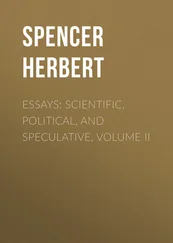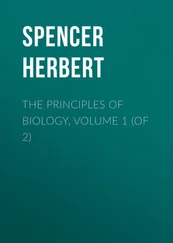"But," it will perhaps be said, "though individual strata are not continuous over large areas, yet systems of strata are. Though within a few miles the same bed gradually passes from clay into sand, or thins out and disappears, yet the group of strata to which it belongs does not do so; but maintains in remote regions the same relations to other groups."
This is the generally-current belief. On this assumption the received geological classifications appear to be framed. The Silurian system, the Devonian system, the Carboniferous system, etc., are set down in our books as groups of formations which everywhere succeed each other in a given order; and are severally everywhere of the same age. Though it may not be asserted that these successive systems are universal; yet it seems to be tacitly assumed that they are. In North and South America, in Asia, in Australia, sets of strata are assimilated to one or other of these groups; and their possession of certain mineral characters and a certain order of superposition are among the reasons assigned for so assimilating them. Though, probably, no competent geologist would contend that the European classification of strata is applicable to the globe as a whole; yet most, if not all geologists, write as though it were. Among readers of works on Geology, nine out of ten carry away the impression that the divisions, Primary, Secondary and Tertiary, are of absolute and uniform application; that these great divisions are separable into subdivisions, each of which is definitely distinguishable from the rest, and is everywhere recognizable by its characters as such or such; and that in all parts of the Earth, these minor systems severally began and ended at the same time. When they meet with the term "Carboniferous era," they take for granted that it was an era universally carboniferous—that it was, what Hugh Miller indeed actually describes it, an era when the Earth bore a vegetation far more luxuriant than it has since done; and were they in any of our colonies to meet with a coal-bed, they would conclude that, as a matter of course, it was of the same age as the English coal-beds.
Now this belief that geologic "systems" are universal, is no more tenable than the other. It is just as absurd when considered a priori ; and it is equally inconsistent with the facts. Though some series of strata classed together as Oolite, may range over a wider district than any one stratum of the series; yet we have but to ask what were the circumstances under which it was deposited, to see that the Oolitic series, like one of its individual strata, must be of local origin; and that there is not likely to be anywhere else, a series which corresponds, either in its characters or in its commencement and termination. For the formation of such a series implies an area of subsidence, in which its component beds were thrown down. Every area of subsidence is necessarily limited; and to suppose that there exist elsewhere groups of beds completely answering to those known as Oolite, is to suppose that, in contemporaneous areas of subsidence, like processes were going on. There is no reason to suppose this; but good reason to suppose the reverse. That in contemporaneous areas of subsidence throughout the globe, the conditions would cause the formation of Oolite, is an assumption which no modern geologist would openly make. He would say that the equivalent series of beds found elsewhere, would probably be of dissimilar mineral character. Moreover, in these contemporaneous areas of subsidence, the processes going on would not only be different in kind; but in no two cases would they be likely to agree in their commencements and terminations. The probabilities are greatly against separate portions of the Earth's surface beginning to subside at the same time, and ceasing to subside at the same time—a coincidence which alone could produce equivalent groups of strata. Subsidences in different places begin and end with utter irregularity; and hence the groups of strata thrown down in them can but rarely correspond. Measured against each other in time, their limits must disagree. On turning to the evidence, we find that it daily tends more and more to justify these a priori positions. Take, as an example, the Old Red Sandstone system. In the north of England this is represented by a single stratum of conglomerate. In Herefordshire, Worcestershire, and Shropshire, it expands into a series of strata from eight to ten thousand feet thick, made up of conglomerates, red, green, and white sandstones, red, green, and spotted marls, and concretionary limestones. To the south-west, as between Caermarthen and Pembroke, these Old Red Sandstone strata exhibit considerable lithological changes; on the other side of the Bristol Channel, they display further changes in mineral characters; while in South Devon and Cornwall, the equivalent strata, consisting chiefly of slates, schists, and limestones, are so wholly different, that they were for a long time classed as Silurian. When we thus see that in certain directions the whole group of deposits thins out, and that its mineral characters change within moderate distances; does it not become clear that the whole group of deposits was a local one? And when we find, in other regions, formations analogous to these Old Red Sandstone or Devonian formations, is it certain—is it even probable—that they severally began and ended at the same time with them? Should it not require overwhelming evidence to make us believe as much?
Yet so strongly is geological speculation swayed by the tendency to regard the phenomena as general instead of local, that even those most on their guard against it seem unable to escape its influence. At page 158 of his Principles of Geology , Sir Charles Lyell says:—
"A group of red marl and red sandstone, containing salt and gypsum, being interposed in England between the Lias and the Coal, all other red marls and sandstones, associated some of them with salt, and others with gypsum, and occurring not only in different parts of Europe, but in North America, Peru, India, the salt deserts of Asia, those of Africa—in a word, in every quarter of the globe, were referred to one and the same period. … It was in vain to urge as an objection the improbability of the hypothesis which implies that all the moving waters on the globe were once simultaneously charged with sediment of a red colour. But the rashness of pretending to identify, in age, all the red sandstones and marls in question, has at length been sufficiently exposed, by the discovery that, even in Europe, they belong decidedly to many different epochs."
Nevertheless, while in this and many kindred passages Sir C. Lyell protests against the bias here illustrated, he seems himself not completely free from it. Though he utterly rejects the old hypothesis that all over the Earth the same continuous strata lie one upon another in regular order, like the coats of an onion, he still writes as though geologic "systems" do thus succeed each other. A reader of his Manual would certainly suppose him to believe, that the Primary epoch ended, and the secondary epoch began, all over the world at the same time—that these terms really correspond to distinct universal eras. When he assumes, as he does, that the division between Cambrian and Lower Silurian in America, answers chronologically to the division between Cambrian and Lower Silurian in Wales—when he takes for granted that the partings of Lower from Middle Silurian, and of Middle Silurian from Upper, in the one region, are of the same dates as the like partings in the other region; does it not seem that he believes geologic "systems" to be universal, in the sense that their separations were in all places contemporaneous? Though he would, doubtless, disown this as an article of faith, is not his thinking unconsciously influenced by it? Must we not say that, though the onion-coat hypothesis is dead, its spirit is traceable, under a transcendental form, even in the conclusions of its antagonists?
Читать дальше












